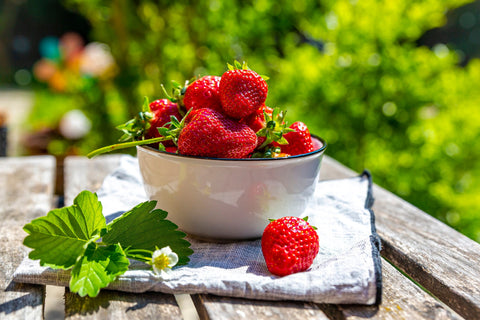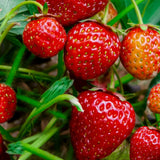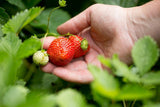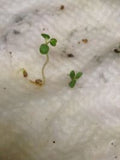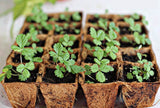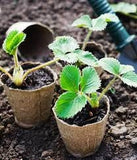A favorite fruit in nearly every culture and cuisine, strawberries are beloved for their sweet, juicy flavor and plump red appearance. And though many people cook with them (and eat them) regularly, few have actually considered growing them themselves.These highly decorative little plants produce delicious, aromatic red great delicious strawberries, same of bigger than the standard type. Perennials, These strawberries stay compact and produce few runners, making them suitable for rock gardens, path edgings, pots, and window boxes.Edible Flowers: Flowers add a mild, strawberry-like flavor if sprinkled on salads or when used as a garnish for drinks and desserts. Once you try one of these mouth watering fruits you will have them in your garden for years to come!Strawberries prefer a sunny to a partially shaded location and moist, well-drained soil, richly fertilized with compost or aged manure, and a pH between 6.5-6.8. Prepare beds the previous fall or in early spring to get good control over perennial weeds.Product Type: Bonsai
Size: Small,Mini,Medium Climate: Temperate Style: Perennial Full-bloom Period: Spring to fall Type: Succulent Plant Use: Outdoor Plants Variety: Strawberry Cultivating Difficulty Degree: Very Easy Hardiness Zone: 4-9One major benefit of growing strawberries from seed is you can plant several different varieties of your choosing, as long as they can grow in your climate. But a drawback is you likely won't have a good harvest of fruit for a year after planting. Most growers recommend pinching off the strawberry flowers the first year to direct the plant's energy into producing strong roots and a good, healthy plant. Enjoy fruit the second and third year. This is certainly a case where good things come to those who wait.PLANTING (SEEDS): Sow seeds thinly in March or April in a fine soilless mix. Press seeds into the moist mix and keeps moist until plants emerge in 2-3 weeks. Keep soil temperature between 60°F (16°C) and 75°F (24°C), if possible. Transplant to plug trays or 1-1 1/2" apart in flats, then to larger pots or planters for retailing full-size plants: 1 plant/3-4" pot; 3-5 plants/8" pot. Transplant outdoors anytime, 1' apart. PLANTING (PLANTS): Space plants 12-18" apart in rows 3-4' apart. Some growers prefer to plant the crowns with closer spacing (5-9" in-row spacing for single rows or staggered double rows with 10-20" in-row spacing) and to remove all runners during the entire life span of the bed. Set plants with the roots straight down into the soil, making sure the middle of the crown is level with the top of the soil. Irrigate and keep free of weeds. Mulch with straw in late fall when plants have started to go dormant to moderate freeze/thaw cycles and heaving. Pull mulch aside in spring when plants start to grow. Leave the mulch in the aisles to keep the fruit clean and help suppress weeds.In general, the strawberry roots can be planted in the ground, in containers, or in hanging pots. Strawberries are extremely adaptable and are grown in every state in the U.S. They will benefit from mulch such as straw, pine needles, or plastic. They prefer soil rich in all the basic nutrients with a pH of 6-6.5.HARVEST: Plants will set fruit from midsummer through October. Production and berry size may decline during the hottest part of summer. Day-neutral beds will last for one to two growing seasons once established. Do not renovate day-neutral varieties.When they are ready to harvest, cut the berry off at the stem. Do not pull the berry from the stem to harvest it. Unwashed strawberries can be stored in the refrigerator for three to five days.Strawberry seeds need to be cold-treated before they’re planted. Pour your seeds into a glass jar and tightly seal the lid on top. Then, slip the jar into the freezer for about 1 month. If you’re in a rush, freeze the seeds for at least 2 weeks. If you don’t chill the seeds ahead of time, they may not germinate properly.Tips: When the strawberries are harvested, they should be slightly firm to the touch, but if strawberries are too mushy, they can be used to make jellies and jams.FAQ Do strawberry plants need full sun? Many types of strawberry plants require at least six to eight hours of sun per day. If they get too hot, though, the fruit can get sunburnt.How often should strawberry plants be watered? Strawberry plants need to be watered on a daily basis, and require quite a bit of water, especially during the warm summer months and when they're bearing fruit.Do strawberry plants propagate? Strawberry plants have runners that stretch out from the plant and produce their own roots. You can clip them off and move them into their own container or within the same garden bed.How do you start a strawberry seed? Sow the seeds thinly, pressing the seeds into a moist potting medium in seed starter trays, and barely cover the seeds with the growing mix. Place the tray under grow lights, as strawberries need light to germinate. Allow several weeks for germination. Be patient: seeds may germinate anywhere from 7 days to 6 weeks.How long does it take to grow strawberries from seed? How long does it take for a strawberry plant to bear fruit? It takes around 3 months for a bareroot strawberry plant to bear fruit. Strawberry plants raised from seed will produce fruit in their second summer as the plant requires its first year to establish and grow.NOTES: Encourage the plant to put its energy into becoming established by removing all the flower buds for the first 6 weeks after setting out your plants. We also recommend that you remove all the runners during the first year.Varieties may also be included in the blend: June-bearing strawberries, also known as Chandler, Earliglow, Jewel, and Cabot, Day-neutral strawberries, Seascape, Evie, and Albion, White Alpine, Everbearing strawberries, Tribute and Tristar, Woodland strawberries, and much more
Size: Small,Mini,Medium Climate: Temperate Style: Perennial Full-bloom Period: Spring to fall Type: Succulent Plant Use: Outdoor Plants Variety: Strawberry Cultivating Difficulty Degree: Very Easy Hardiness Zone: 4-9One major benefit of growing strawberries from seed is you can plant several different varieties of your choosing, as long as they can grow in your climate. But a drawback is you likely won't have a good harvest of fruit for a year after planting. Most growers recommend pinching off the strawberry flowers the first year to direct the plant's energy into producing strong roots and a good, healthy plant. Enjoy fruit the second and third year. This is certainly a case where good things come to those who wait.PLANTING (SEEDS): Sow seeds thinly in March or April in a fine soilless mix. Press seeds into the moist mix and keeps moist until plants emerge in 2-3 weeks. Keep soil temperature between 60°F (16°C) and 75°F (24°C), if possible. Transplant to plug trays or 1-1 1/2" apart in flats, then to larger pots or planters for retailing full-size plants: 1 plant/3-4" pot; 3-5 plants/8" pot. Transplant outdoors anytime, 1' apart. PLANTING (PLANTS): Space plants 12-18" apart in rows 3-4' apart. Some growers prefer to plant the crowns with closer spacing (5-9" in-row spacing for single rows or staggered double rows with 10-20" in-row spacing) and to remove all runners during the entire life span of the bed. Set plants with the roots straight down into the soil, making sure the middle of the crown is level with the top of the soil. Irrigate and keep free of weeds. Mulch with straw in late fall when plants have started to go dormant to moderate freeze/thaw cycles and heaving. Pull mulch aside in spring when plants start to grow. Leave the mulch in the aisles to keep the fruit clean and help suppress weeds.In general, the strawberry roots can be planted in the ground, in containers, or in hanging pots. Strawberries are extremely adaptable and are grown in every state in the U.S. They will benefit from mulch such as straw, pine needles, or plastic. They prefer soil rich in all the basic nutrients with a pH of 6-6.5.HARVEST: Plants will set fruit from midsummer through October. Production and berry size may decline during the hottest part of summer. Day-neutral beds will last for one to two growing seasons once established. Do not renovate day-neutral varieties.When they are ready to harvest, cut the berry off at the stem. Do not pull the berry from the stem to harvest it. Unwashed strawberries can be stored in the refrigerator for three to five days.Strawberry seeds need to be cold-treated before they’re planted. Pour your seeds into a glass jar and tightly seal the lid on top. Then, slip the jar into the freezer for about 1 month. If you’re in a rush, freeze the seeds for at least 2 weeks. If you don’t chill the seeds ahead of time, they may not germinate properly.Tips: When the strawberries are harvested, they should be slightly firm to the touch, but if strawberries are too mushy, they can be used to make jellies and jams.FAQ Do strawberry plants need full sun? Many types of strawberry plants require at least six to eight hours of sun per day. If they get too hot, though, the fruit can get sunburnt.How often should strawberry plants be watered? Strawberry plants need to be watered on a daily basis, and require quite a bit of water, especially during the warm summer months and when they're bearing fruit.Do strawberry plants propagate? Strawberry plants have runners that stretch out from the plant and produce their own roots. You can clip them off and move them into their own container or within the same garden bed.How do you start a strawberry seed? Sow the seeds thinly, pressing the seeds into a moist potting medium in seed starter trays, and barely cover the seeds with the growing mix. Place the tray under grow lights, as strawberries need light to germinate. Allow several weeks for germination. Be patient: seeds may germinate anywhere from 7 days to 6 weeks.How long does it take to grow strawberries from seed? How long does it take for a strawberry plant to bear fruit? It takes around 3 months for a bareroot strawberry plant to bear fruit. Strawberry plants raised from seed will produce fruit in their second summer as the plant requires its first year to establish and grow.NOTES: Encourage the plant to put its energy into becoming established by removing all the flower buds for the first 6 weeks after setting out your plants. We also recommend that you remove all the runners during the first year.Varieties may also be included in the blend: June-bearing strawberries, also known as Chandler, Earliglow, Jewel, and Cabot, Day-neutral strawberries, Seascape, Evie, and Albion, White Alpine, Everbearing strawberries, Tribute and Tristar, Woodland strawberries, and much more

